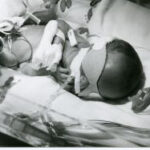Has breastfeeding made one of your breasts bigger than the other? Worried that once you wean your child, your breasts won’t return to normal? Relax, you’re not alone.
First and foremost, congratulations. As you well know, by choosing to breastfeed, you are doing the best that you can for your child. Second, stop feeling guilty for being concerned about something as seemingly “shallow” as the shape of your breasts. After all, you’re a woman. There is nothing wrong with being concerned about the well-being of both your baby AND your breasts. In fact, while right now it may seem like you have had to choose between the two, after reading this article, you will realize that you can have both.
More women than not quickly learn that for a number of reasons, their baby prefers one breast over the other. Perhaps your baby is more comfortable on one side. Maybe you have more milk ducts in your right breast. Maybe your left nipple was inverted or flat. Or maybe your baby just prefers a certain side, for reasons unknown. After all, even newborns have their own personalities. Fortunately, just because your baby refuses to nurse on one side, doesn’t mean you are forever fated to have lop-sided breasts. In fact, most women agree that once they have weaned their child, their breasts returned to normal.
Ok, so you don’t exactly want to walk around in baggy t-shirts for the next 2 years. Many women have found that by changing their nursing routine, they were able to “even out” their breasts within a few days.
Milk works by supply and demand. This means that if one breast is bigger, it is because the demand for milk is greater. To get the other breast up to size, you need to increase its milk demand. In other words, it is time to give the underdog some attention. Try starting each nursing session on your weaker side. If you only nurse on one breast at a time, nurse at a ratio of two to one, in favor of your smaller breast. For every two nursing sessions on that breast, do one on the other. You can also pump for a few minutes after each session on your smaller breast. Be careful not to allow your breadwinner to get too full, though. Pump just enough on that breast to relieve pressure and to prevent engorgement and/or mastitis.
If your baby refuses to nurse on one side, you can still take measures to try and even out your breasts. There are a number of things you can do to get your baby to nurse on the less favored side. Try switching positions. While the football hold might work wonderfully on your right side, it may not be as comfortable for your baby on your left. You can also try offering the smaller breast right when your baby first wakes up and is more likely to instinctively nurse. Try gently rocking and/or bouncing your baby while on this breast. You can also try pumping first to encourage a quicker letdown.
When it comes to breastfeeding, patience is key. It could take up to a week before you see any change in your breasts. If you still have not within a week, don’t fret. There is still a good chance that once you quit breastfeeding, your breasts will return to normal. In the meantime, relax and enjoy nursing your baby. They grow fast and this amazing time will be over before you know it.



